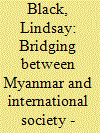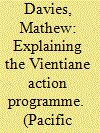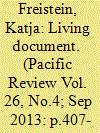|
|
|
Sort Order |
|
|
|
Items / Page
|
|
|
|
|
|
|
| Srl | Item |
| 1 |
ID:
123111


|
|
|
|
|
| Publication |
2013.
|
| Summary/Abstract |
Numerous academic works have critiqued Japan's Official Development Assistance (ODA) programme for being mercantilist and failing to promote democratization and human rights (Orr 1990; Rix 1993; Arase 1995, 2005). Such accounts assess Japan's ODA policy from Western theoretical perspectives that advocate Western approaches, such as military and economic interventions to contain repressive states. While receptive to these criticisms, Japanese policy-makers have perceived their country's international role in 'bridging' (kakehashi) terms and structured their ODA accordingly, as this paper details in the case of Japan's ODA policy towards Myanmar. 1
The rationale behind Japan's kakehashi approach lies in the construction of Japan's self-identity as a state able to reenter international society after World War II through focusing on economic development rather than military and coercive action. Proponents of the kakehashi approach construct Japan both as a model of successful democratization through development which other states can learn from, as well as the means through ODA to 'bridge' the divide between repressive regimes and liberal democratic capitalism. This critical approach examines Japan's kakehashi or bridging strategy in terms of Japan's response to the anti-government protests in September 2007, Cyclone Nargis in May 2008, and in the build up to parliamentary elections in November 2010 in Myanmar to demonstrate the permanence of this approach in spite of a change of government in Japan. In so doing, the kakehashi approach reveals opportunities to engage with, rather than contain, repressive regimes, thereby raising the possibility of enticing such states back into international society though economic incentives.
|
|
|
|
|
|
|
|
|
|
|
|
|
|
|
|
| 2 |
ID:
123112


|
|
|
|
|
| Publication |
2013.
|
| Summary/Abstract |
This article uses extensive fieldwork data to focus on the question of how Chinese and Japanese companies are competing in neighboring countries of Asia, and what economic forces will shape their future growth in the region. It begins by briefly discussing the history of Chinese and Japanese investment in the South and Southeast Asian regions. It traces the development of Japanese overseas investment policies, as well as China's more recent 'Going Out' government program to encourage overseas flows of capital. It then builds on prior political economy work as it uses case study focuses, with primary data based on the author's fieldwork research in several nations of Southeast Asia and in India, of the two key sectors of automobiles and electronics. It compares and contrasts the investment strategies of companies from each country, as well as the successes and failures of investments in the industries. It finds that Japanese companies' advantages lie in industries utilizing advanced technology and management skills. Though the Japanese continue to lead in many areas, including automobiles, they have begun to face competition and potentially reduced profits in vital manufacturing areas. Meanwhile, Chinese overseas companies have made significant advances in the consumer electronics sector, using low prices and good quality, though overseas automobile investments have gained little traction. The article concludes that, if the Chinese can improve their product quality, capitalize on improving managerial skills and a deeper level of experience in the region, and establish brands they can sell with reliable distribution networks, Japanese companies could face losses to their Asian neighbor in these important parts of the continent they have dominated for decades.
|
|
|
|
|
|
|
|
|
|
|
|
|
|
|
|
| 3 |
ID:
123113


|
|
|
|
|
| Publication |
2013.
|
| Summary/Abstract |
Existing explanations for the emergence of human rights on the political agenda in ASEAN focus either on the role of external pressure on ASEAN member states to 'do something', or on the way those states copied the form, but not the function, of other regional organisations such as the EU. Both approaches tacitly acknowledge that given the strong preference for intergovernmental governance displayed by ASEAN, regardless of interpretations, that it was states that drove the institutionalisation of rights forwards. Through examining in detail the causes and consequences of the Vientiane Action Programme this article disagrees with that assertion. At crucial moments before and after 2004 it was the Working Group for the Establishment of an ASEAN Human Rights Mechanism, a track III actor, which both inserted human rights into ASEAN discussions and forged the link between protecting those rights and the continuing success of ASEAN's security goals. Through understanding the role of the Working Group as a norm entrepreneur, assisting in the localisation of human rights standards, this article suggests that existing explanations of ASEAN institutionalisation need to be revised to include a wider range of political dynamics than previously were acknowledged.
|
|
|
|
|
|
|
|
|
|
|
|
|
|
|
|
| 4 |
ID:
123114


|
|
|
|
|
| Publication |
2013.
|
| Summary/Abstract |
Many recent analyses of the ASEAN Charter have tended to view the document very critically, judging the chances for implementation as low. In order to assess the potential of the Charter, this article argues, an analysis of the Charter needs to take its text seriously and look for the promises and the political consequences they entail. Taking textual representations of the Charter as its empirical basis, the article is based on a deconstructive reading of the legal text and focuses on some of the more controversial promises like democracy promotion, human rights and the role of the regional populations. The article takes into account the political struggles mirrored in the Charter and stresses conflict rather than consensus as a dominant mode of politics within ASEAN.
|
|
|
|
|
|
|
|
|
|
|
|
|
|
|
|
|
|
|
|
|